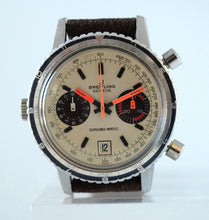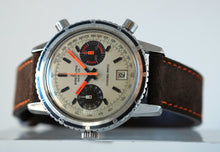
Breitling Chrono-Matic Ref. 2110
Case: stainless steel, polished and brushed, screw back, two round chronograph buttons in the right band, winding crown in the left band at 9 o’clock, bezel with outer black ring for 12 hour indication
Dial: silvered dial, applied baton numerals, neon orange hands with luminous fill, neon orange central chronograph hand, outer tachometer scale, two black subsidiary dials for 12 hour register and 30 minute register with 5 minute intervals in red, date window at 6 o’clock
Movement: Cal. 12 with switching wheel, rhodium-plated, 17 jewels, lever escapement, monometallic balance, self-compensating flat balance-spring.Dial, case and movement signed.
Ref: 2110
Case No. 12xxxx
Diameter: 39 mm
Circa 1971
More about Breitling:
By the 1960s, many brands had begun the attempt to create an automatic chronograph movement. Two main groups were competing to develop this first – Movado/Zenith, and Heuer/Breitling/Hamilton/Dubois Depraz. Since both groups exhibited their new automatic chronograph wristwatches at Basel in 1969, both claimed to be the first. There is still debate today as to which group can claim the title of producing the first automatic chronograph, but it is accepted that since the Chrono-matic was the first to be available to the public for purchase, it wins the title.
In 1965, the group of Heuer, Breitling, Hamilton, and Dubois Depraz began working on the project, dubbed “Project 99”, with each company being responsible for a part of the final watch. In 1967, a patent was filed for the caliber 11, and in 1968 the first prototypes were developed. In September of 1968, Breitling manufactured the first Chrono-matic wristwatch.
The design of the caliber 11 in the Chrono-matic was interesting in that it required the winding crown to be located on the opposite side of the chronograph pushers, by 9 o’clock. Since the watch had an automatic movement and would not need to be wound by hand as much, it was decided by the four firms that moving the crown to the opposite side was best.
The caliber 11 was updated to the caliber 12, as found in the present watch. The caliber 12 beat at a faster rate of 21,600 bps, compared to 19,800 bps of the caliber 11. The brass parts of the movement on the caliber 12 would also be gold-plated instead of nickel-plated.


















